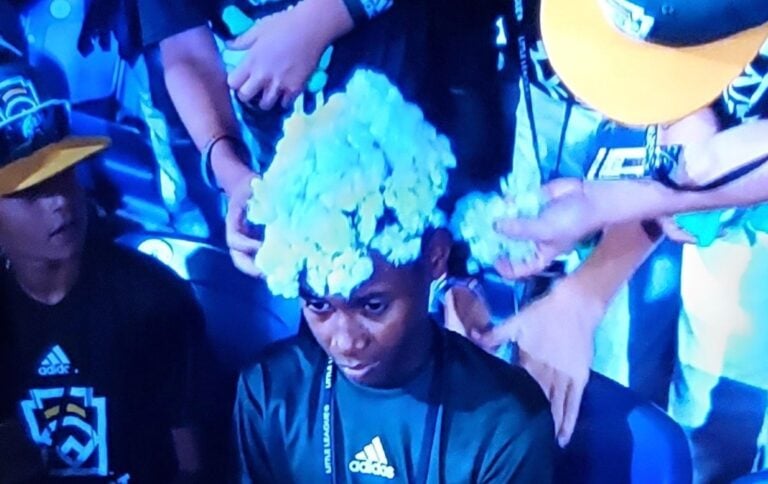A Davenport, Iowa, little league team was seen on national TV putting cotton in their black teammate’s hair.
Writer for BSO, Robert Littal, recently reported that a black child was the victim of a racist hazing incident which was shown on live TV during the Little League World Series and was promoted by ESPN.
The BSO article reported that ESPN covered the event as, “kids being kids” and that it was a sort of hazing ritual for the black child to go through.
“Twitter Wants Answers From the Little League and ESPN on Why They Promoted a Black Child Having Cotton Put on His Head Like a Pet By His Teammates and Coaches During Little League World Series Coverage (Tweets-Photos) bit.ly/3pC9sfa”
Twitter Wants Answers From the Little League and ESPN on Why They Promoted a Black Child Having Cotton Put on His Head Like a Pet By His Teammates and Coaches During Little League World Series Coverage (Tweets-Photos) https://t.co/mLHWlilG7V pic.twitter.com/n9CIOH3kHZ
— Robert Littal BSO (@BSO) August 22, 2022
Love Film & TV?
Get your daily dose of everything happening in music, film and TV in Australia and abroad.
Littal reported that the coaches also failed to take action in the incident and may have even participated. They concluded the report by including a passage about what it was like to work in a cotton field as a slave during American chattel slavery:
He had been a driver and overseer in his younger years, but at this time was in possession of a plantation on Bayou Huff Power, two and a half miles from Holmesville, eighteen from Marksville, and twelve from Cheneyville. It belonged to Joseph B. Roberts, his wife’s uncle, and was leased by Epps. His principal business was raising cotton, and inasmuch as some may read this book who have never seen a cotton field, a description of the manner of its culture may not be out of place.
The ground is prepared by throwing up beds or ridges, with the plough&151;back-furrowing, it is called. Oxen and mules, the latter almost exclusively, are used in ploughing. The women as frequently as the men perform this labor, feeding, currying and taking care of their teams, and in all respects doing the field and stable work, precisely as do the ploughboys of the North.
The beds, or ridges, are six feet wise, that is, from water furrow to water furrow. A plough drawn by one mule is then run along the top of the ridge or center of the bed, making the drill, into which a girl usually drops the seed, which she carries in a bag hung round her neck. Behind her comes a mule and harrow, covering up the seed, so that two mules, three slaves, a plough and harrow, are employed in planting a row of cotton. This is done in the months of March and April. Corn is planted in February. When there are no cold rains, the cotton usually makes its appearance in a week. In the course of eight or ten days afterwards the first hoeing in commenced. This is performed in part, also, by the aid of the plough and mule. The plough passes as near as possible to the cotton on both sides, throwing the furrow from it. Slaves follow with their hoes, cutting up the grass and cotton, leaving hills two feet and a half apart. This is called scraping cotton. In two weeks more commences the second hoeing. This time the furrow is thrown towards the cotton. Only one stalk, the largest, is now left standing in each hill. In another fortnight it is hoed the third time, throwing the furrow towards the cotton in the same manner as before, and killing all the grass between the rows. About the first of July, when it is a foot high or thereabouts, it is hoed the fourth and last time. Now the whole space between the rows is ploughed, leaving a deep water furrow in the center. During all these hoeings the overseer or driver follows the slaves on horseback with a whip, such as has been described. The faster hoer takes the lead row. He is usually about a rod in advance of his companions. If one of them passes him, he is whipped. If one falls behind or is a moment idle, he is whipped. In fact, the lash is flying from morning until night, the whole day long. The hoeing season thus continues from April until July, a field having so sooner been finished once, than it is commenced again.
In the latter part of August begins the cotton picking season. At this time each slave is presented with a sack. A strap is fastened to it, which goes over the neck, holding the mouth of the sack breast high, while the bottom reaches nearly to the ground. Each one is also presented with a large basket that will hold about two barrels. This to put the cotton in when the sack is filled. The baskets are carried to the field and placed at the beginning of the rows.
When a new hand, one unaccustomed to the business, is sent for the first time into the field, he is whipped up smartly, and made for that day to pick as fast as he can possibly. At night it is weighed, so that his capability in cotton picking is known. He must bring in the same weight each night following. If it falls short, it is considered that he has been laggard, and a greater or less number of lashes is the penalty.
An ordinary day’s work is two hundred pounds. A slave who is accustomed to picking, is punished, if he or she brings in a less quantity than that. There is a great difference among them as regards this kind of labor. Some of them seem to have a natural knack, or quickness, which enables them to pick with great celerity, and with both hands, while others, with whatever practice or industry, are utterly unable to come up to the ordinary standard. Such hands are taken from the cotton field and employed in other business. . . .


































